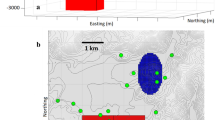Abstract
In an elementary approach every geometrical height difference between the staff points of a levelling line should have a corresponding average g value for the determination of potential difference in the Earth’s gravity field. In practice this condition requires as many gravity data as the number of staff points if linear variation of g is assumed between them. Because of the expensive fieldwork, the necessary data should be supplied from different sources. This study proposes an alternative solution, which is proved at a test bed located in the Mecsek Mountains, Southwest Hungary, where a detailed gravity survey, as dense as the staff point density (~1 point/34 m), is available along a 4.3-km-long levelling line. In the first part of the paper the effect of point density of gravity data on the accuracy of potential difference is investigated. The average g value is simply derived from two neighbouring g measurements along the levelling line, which are incrementally decimated in the consecutive turns of processing. The results show that the error of the potential difference between the endpoints of the line exceeds 0.1 mm in terms of length unit if the sampling distance is greater than 2 km. Thereafter, a suitable method for the densification of the decimated g measurements is provided. It is based on forward gravity modelling utilising a high-resolution digital terrain model, the normal gravity and the complete Bouguer anomalies. The test shows that the error is only in the order of 10−3mm even if the sampling distance of g measurements is 4 km. As a component of the error sources of levelling, the ambiguity of the levelled height difference which is the Euclidean distance between the inclined equipotential surfaces is also investigated. Although its effect accumulated along the test line is almost zero, it reaches 0.15 mm in a 1-km-long intermediate section of the line.
Similar content being viewed by others
References
Allister NA, Featherstone WE (2001) Estimation of Helmert orthometric heights using digital barcode levelling, observed gravity and topographic mass-density data over part of Darling Scarp, Western Australia. Geomatics Res Australas 75: 25–52
Biró P (1983) Time variation of height and gravity. Herber Wichmann Verlag, Karlsruhe
Benedek J (2004) The application of polyhedron volume elements in the calculation of gravity related quantities. In: Meurers B, Pail R (eds) Proceedings of the 1st Workshop on International Gravity Field Research, Graz 2003. Österreichische Beiträge zu Meteorologie und Geophysik, Heft 31:99–106
Benedek J, Papp G (2005) Evaluation of gravity measurements for instrument investigation (in Hungarian with English abstract). Geomatikai Közlemények VIII:201–208
Benedek J, Papp G (2008) Geophysical inversion of on board satellite gradiometer data: a feasibility study in the ALPACA region, central Europe. Acta Geod Geoph Hung (in press)
Bomford G (1962) Geodesy, 2nd edn. Oxford University Press
Csapó G, Völgyesi L (2002) Hungary’s new gravity base network (MGH-2000) and its connection to the “European Unified Gravity Network”. Ser. IAG Symposia, vol 125. Springer, Berlin, pp 72–77
Grenerczy G, Kenyeres A, Fejes I (2000) Present crustal movement and strain distribution in Central Europe inferred from GPS measurements. J Geophys Res 105(B9): 21.835–21.846
Heiskanen WA, Moritz H (1967) Physical geodesy. Freeman, San Francisco
Hwang C, Hsiao Y-S (2003) Orthometric corrections from levelling, gravity, density and elevation data: a case study in Taiwan. J Geod 77: 279–291
Joó I (1992) Recent vertical surface movements in the Carpathian basin. Tectonophysics 202: 120–134
Joó I, Arabadzisjski D, Füry M, Mescerszkij G, Mihaila M, Mladenovski MM, Németh Zs, Steinberg J, Thury J, Wyrzykowski T (1987) New investigations of recent crustal movements in the Carpatho-Balkan region. J Geodynamics 8(2–4): 99–113
Kenyeres A (1999) Technology development for GPS heighting in Hungary. Rep Geod 5(46): 89–96
Levallois JJ (1964) Sur la fréquence des mesures de pesentaur dans les nivelliments. Bull Géod 74: 317–325
Mollweide KB (1813) Auflösung einiger die Anziehing von Linien, Flächen und Körpern betreffenden Aufgaben unter denen auch die in der Monatl Corresp Bp XXIV. S. 522. vorgelegte sich findet. Zach’s Monatliche Correspondenz zur Beförderung der Erd und Himmelskunde. Bd XXVII:26–38
Nagy D, Papp G, Benedek J (2000) The gravitational potential and its derivatives for the prism. J Geod 74: 552–560
Papp G (2008) Simultaneous determination of terrain correction and local average topographic density. Acta Geod Geoph Hung (in press)
Pohánka V (1988) Optimum expression for computation of the gravity field of homogeneous polyhedron body. Geophys Prospecting 36: 733–751
Ramsayer K (1963) Über den zulassigen Abstand der Schwerepunkte bei der Bestimmung geopotentieller Koten im Hochgebirge, Mittelgebirge und Flachland. Deutche Geodätische Komission, Reiche A, Heft Nr. 44
Rónai A, Hámor G, Nagy E, Fülöp J, Császár G, Jámbor A, Hetényi R, Deák M, Gyarmati P (1984) Geological map of Hungary 1:500000, Magyar Állami Földtani Intézet, Budapest
Sansò F, Vaní P (2006) The orthometric height and the holonomity problem. J Geod 80: 225–232
Tenzer R, Vaníček P, Santos M, Featherstone WE, Kuhn M (2005) The rigorous determination of orthometric heights. J Geod 79: 82–92
Torge WT (2001) Geodesy, 3rd edn. Walter de Gruyter, Berlin
Völgyesi L, Szabó Z, Csapó G (2005) Relation between time variation of gravity and Pannonian sediment thickness in the Carpathian basin. Reports on Geodesy, Warsaw University of Technology 73(2):255–262
Author information
Authors and Affiliations
Corresponding author
Rights and permissions
About this article
Cite this article
Papp, G., Szeghy, E. & Benedek, J. The determination of potential difference by the joint application of measured and synthetical gravity data: a case study in Hungary. J Geod 83, 509–521 (2009). https://doi.org/10.1007/s00190-008-0257-2
Received:
Accepted:
Published:
Issue Date:
DOI: https://doi.org/10.1007/s00190-008-0257-2




